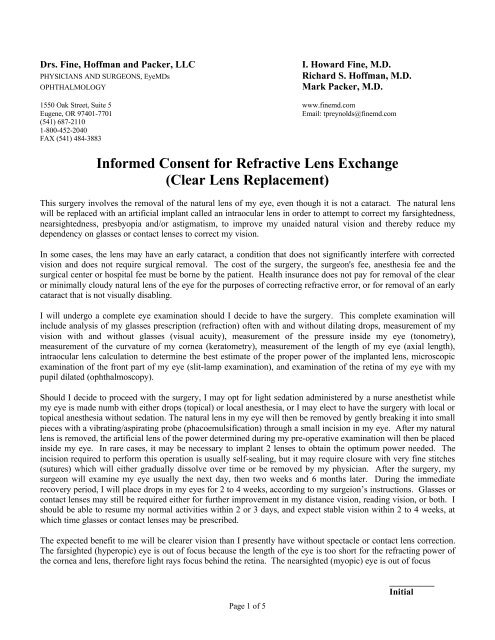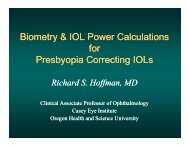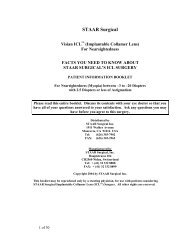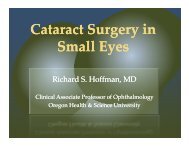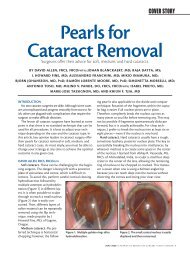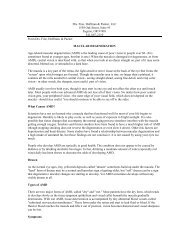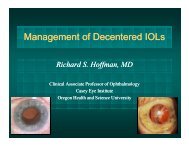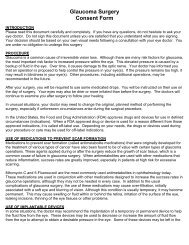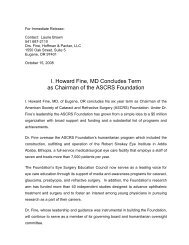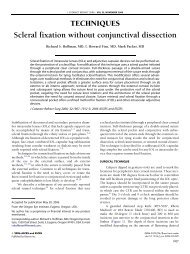Informed Consent for Refractive Lens Exchange - Drs. Fine, Hoffman ...
Informed Consent for Refractive Lens Exchange - Drs. Fine, Hoffman ...
Informed Consent for Refractive Lens Exchange - Drs. Fine, Hoffman ...
You also want an ePaper? Increase the reach of your titles
YUMPU automatically turns print PDFs into web optimized ePapers that Google loves.
<strong>Drs</strong>. <strong>Fine</strong>, <strong>Hoffman</strong> and Packer, LLC I. Howard <strong>Fine</strong>, M.D.<br />
PHYSICIANS AND SURGEONS, EyeMDs Richard S. <strong>Hoffman</strong>, M.D.<br />
OPHTHALMOLOGY Mark Packer, M.D.<br />
1550 Oak Street, Suite 5 www.finemd.com<br />
Eugene, OR 97401-7701 Email: tpreynolds@finemd.com<br />
(541) 687-2110<br />
1-800-452-2040<br />
FAX (541) 484-3883<br />
<strong>In<strong>for</strong>med</strong> <strong>Consent</strong> <strong>for</strong> <strong>Refractive</strong> <strong>Lens</strong> <strong>Exchange</strong><br />
(Clear <strong>Lens</strong> Replacement)<br />
This surgery involves the removal of the natural lens of my eye, even though it is not a cataract. The natural lens<br />
will be replaced with an artificial implant called an intraocular lens in order to attempt to correct my farsightedness,<br />
nearsightedness, presbyopia and/or astigmatism, to improve my unaided natural vision and thereby reduce my<br />
dependency on glasses or contact lenses to correct my vision.<br />
In some cases, the lens may have an early cataract, a condition that does not significantly interfere with corrected<br />
vision and does not require surgical removal. The cost of the surgery, the surgeon's fee, anesthesia fee and the<br />
surgical center or hospital fee must be borne by the patient. Health insurance does not pay <strong>for</strong> removal of the clear<br />
or minimally cloudy natural lens of the eye <strong>for</strong> the purposes of correcting refractive error, or <strong>for</strong> removal of an early<br />
cataract that is not visually disabling.<br />
I will undergo a complete eye examination should I decide to have the surgery. This complete examination will<br />
include analysis of my glasses prescription (refraction) often with and without dilating drops, measurement of my<br />
vision with and without glasses (visual acuity), measurement of the pressure inside my eye (tonometry),<br />
measurement of the curvature of my cornea (keratometry), measurement of the length of my eye (axial length),<br />
intraocular lens calculation to determine the best estimate of the proper power of the implanted lens, microscopic<br />
examination of the front part of my eye (slit-lamp examination), and examination of the retina of my eye with my<br />
pupil dilated (ophthalmoscopy).<br />
Should I decide to proceed with the surgery, I may opt <strong>for</strong> light sedation administered by a nurse anesthetist while<br />
my eye is made numb with either drops (topical) or local anesthesia, or I may elect to have the surgery with local or<br />
topical anesthesia without sedation. The natural lens in my eye will then be removed by gently breaking it into small<br />
pieces with a vibrating/aspirating probe (phacoemulsification) through a small incision in my eye. After my natural<br />
lens is removed, the artificial lens of the power determined during my pre-operative examination will then be placed<br />
inside my eye. In rare cases, it may be necessary to implant 2 lenses to obtain the optimum power needed. The<br />
incision required to per<strong>for</strong>m this operation is usually self-sealing, but it may require closure with very fine stitches<br />
(sutures) which will either gradually dissolve over time or be removed by my physician. After the surgery, my<br />
surgeon will examine my eye usually the next day, then two weeks and 6 months later. During the immediate<br />
recovery period, I will place drops in my eyes <strong>for</strong> 2 to 4 weeks, according to my surgeion’s instructions. Glasses or<br />
contact lenses may still be required either <strong>for</strong> further improvement in my distance vision, reading vision, or both. I<br />
should be able to resume my normal activities within 2 or 3 days, and expect stable vision within 2 to 4 weeks, at<br />
which time glasses or contact lenses may be prescribed.<br />
The expected benefit to me will be clearer vision than I presently have without spectacle or contact lens correction.<br />
The farsighted (hyperopic) eye is out of focus because the length of the eye is too short <strong>for</strong> the refracting power of<br />
the cornea and lens, there<strong>for</strong>e light rays focus behind the retina. The nearsighted (myopic) eye is out of focus<br />
Page 1 of 5<br />
__________<br />
Initial
ecause the length of the eye is too long <strong>for</strong> the refracting power of the cornea and lens, there<strong>for</strong>e light rays focus in<br />
front of the retina. The light rays can theoretically be brought to focus on the retina by substituting an artificial lens<br />
that has the proper power, thereby improving the focus of the eye. Although this can theoretically improve my<br />
unaided distance and/or near vision, I may still require additional glasses <strong>for</strong> reading, driving, and other activities.<br />
Description of risks and side effects, <strong>for</strong>eseeable risks and discom<strong>for</strong>ts:<br />
<strong>Refractive</strong> <strong>Lens</strong> <strong>Exchange</strong> is usually quite com<strong>for</strong>table <strong>for</strong> the patient. Mild discom<strong>for</strong>t <strong>for</strong> the first 24 hours is<br />
typical, with severe pain being extremely unusual. Since this surgery is essentially the same as cataract surgery, the<br />
same risks apply. Complications of cataract surgery may include but are not limited to: infection (which if serious<br />
can lead to complete loss of vision); swelling in the central area of the retina (called cystoid macular edema which<br />
usually improves with time); clouding of the outer lens of the eye (corneal edema which can be corrected with a<br />
corneal transplant); detachment of the retina (an increased risk in highly near-sighted eyes even though the retinal<br />
detachment can usually be repaired); damage to the retina or nerve during the administration of the anesthesia if an<br />
injection is per<strong>for</strong>med: increased astigmatism; inaccuracy of the intraocular lens power; decentration of the<br />
intraocular lens, which may provide unwanted images and increased glare; and development of increased pressure<br />
in the eye (glaucoma). Some or all of these complications can occur, however, their incidence following cataract<br />
surgery is exceptionally low.<br />
In this procedure the front part of the capsule (membrane enclosing the lens) is opened and the natural lens is<br />
removed, with the back part of the capsule left in place to support the intraocular lens. Many months or even years<br />
after the surgery, this capsule remnant may become cloudy and cause blurry or poor vision. This cloudy remnant is<br />
called capsular opacity or posterior capsular fibrosis. The way to make vision clear again is with a posterior laser<br />
capsulotomy, which simply means making an opening in the back of the capsule with a laser. (When this occurs the<br />
laser procedure is per<strong>for</strong>med as a medically necessary procedure and is generally covered by medical insurance.)<br />
Although the accuracy of intraocular lens calculations is quite satisfactory <strong>for</strong> normal sized eyes, these calculations<br />
can be less accurate <strong>for</strong> unusually long or short eyes. The best available calculation <strong>for</strong>mula will be used to evaluate<br />
the power of the lens to be implanted. In the event of a minor amount of residual myopia, hyperopia and/or<br />
astigmatism, the vision can usually be corrected by a glasses prescription, which should be considerably weaker<br />
than the patient’s original prescription. A large amount of residual myopia, hyperopia, and/or astigmatism error<br />
may be corrected by a stronger pair of glasses, laser surgery, contact lenses, the exchange of the implant or the<br />
insertion of a second implant in another operation.<br />
Since only one eye will undergo surgery at a time the patient may, depending on the refractive error, experience a<br />
period of imbalance between the two eyes (anisometropia). This usually cannot be corrected with spectacle glasses<br />
because of the marked difference in the prescription need <strong>for</strong> each eye, so the patient will either temporarily have to<br />
wear a contact lens in the non-operated eye or will have to function with only one clear eye <strong>for</strong> distance vision. In<br />
the absence of complications, surgery in the second eye can usually be accomplished within a few days once the<br />
first eye is stabilized.<br />
MULTIFOCAL LENS IMPLANT:<br />
The Array Multifocal lens implant is different from a monofocal lens implant. It is made of the same materials and<br />
basic design as many of the monofocal lenses, but in addition to providing clear vision at far distances, it also<br />
provides good focus <strong>for</strong> a range of near distances, such as the computer monitor and reading. Visual side effects<br />
may include halos and glare, which most patients report decrease in time and/or they grow accustomed to the<br />
symptom<br />
Page 2 of 5<br />
__________<br />
Initial
as time passes. Halos at night may persist indefinitely with some patients. You may also notice a loss of contrast,<br />
which can effect the quality of your vision at night and in low light conditions. FDA studies show that the contrast<br />
loss measured was insignificant.<br />
MONOFOCAL LENS IMPLANT:<br />
One definite disadvantage of having the clear lens removed, especially in a patient less than 40 years of age, is the<br />
loss of the near focusing power of the eye (accommodation). Thus, it must be clearly understood that even with a<br />
successful surgery and an accurate intraocular lens calculation targeted to correct the eye’s distance vision, close<br />
vision without spectacles will be blurred, and will require spectacles <strong>for</strong> close and intermediate vision. It may be<br />
possible to deliberately correct one eye <strong>for</strong> close vision instead of distance. This would allow the patient to read<br />
without glasses, even though the eye would then be nearsighted and require a corrective lens <strong>for</strong> distance vision.<br />
This combination of a distance eye with a reading eye is called monovision. It has been employed quite<br />
successfully in many contact lens patients and this option can be demonstrated with contact lenses if desired.<br />
Non-surgical alternatives:<br />
Non-surgical alternatives to refractive lens exchange is to wear spectacle lenses or contact lenses. Although there<br />
are essentially no risks to wearing glasses, the quality of vision with strong farsighted or nearsighted glasses is not<br />
normal because of an enlarged or minified image and a slight decrease in peripheral vision caused by the thickness<br />
of the lenses. Although contact lenses provide higher quality and more normal vision, they have a slight risk of<br />
complications, especially if they are worn overnight. The risks of contact lenses include: infection, (which can<br />
rarely cause loss of vision if the infection involves the cornea); allergies (giant papillary conjunctivitis, or GPC<br />
which can make wearing the lenses impossible); mild irritation and discom<strong>for</strong>t. There is also evidence that some<br />
damage may occur to the important internal layer of cells that are responsible <strong>for</strong> keeping the cornea clear. This<br />
damage may cause harm if the contact lenses are worn <strong>for</strong> many years and it is unknown whether this damage will<br />
eventually lead to serious long-term complications such as corneal clouding. Contact lenses or glasses are nonsurgical,<br />
extremely accurate, permit easy changes in prescription and also allows the eye to retain its focusing power<br />
<strong>for</strong> near vision be<strong>for</strong>e age 45.<br />
Surgical alternatives (including lasers):<br />
There are several other procedures <strong>for</strong> the correction of farsightedness, nearsightedness and astigmatism.<br />
The excimer and holmium lasers are capable of reshaping the cornea. The excimer laser can be used to correct low<br />
to moderate amounts of hyperopia, myopia and astigmatism through PRK (photorefractive keratectomy) or LASIK<br />
(laser insitu keratomileusis) procedures. The holmium laser is indicated <strong>for</strong> low degrees of hyperopia only.<br />
Conductive Keratoplasty (CK) uses radiofrequency energy, instead of a laser, to reshape the cornea. CK is<br />
indicated <strong>for</strong> low degrees of hyperopia only.<br />
LASIK, the most commonly per<strong>for</strong>med of these alternatives, is an operation that combines the creation of a flap<br />
with the microkeratome and the removal of tissue with the excimer laser. LASIK has been found to be quite<br />
successful and relatively safe <strong>for</strong> the correction of moderate and high myopia, up to about –12.00 diopters. LASIK<br />
is complicated by problems with accuracy and the quality of vision, especially at night, above -12 diopters. Many<br />
surgeons have stopped per<strong>for</strong>ming LASIK <strong>for</strong> extremely near-sighted eyes.<br />
Page 3 of 5<br />
__________<br />
Initial
The advantage to all the above procedures is retaining the under 45 year old patient’s natural near focusing power<br />
and no incision into the inside of the eye. I understand that I may choose not to have this surgery and continue<br />
wearing my glasses or contact lenses or I may elect to have one of the other procedures discussed in this section.<br />
I understand that I will be responsible <strong>for</strong> the costs of any surgery-related injuries. I also understand that no<br />
compensation is being offered to me in the event of an injury or complication. In the event of a complication from<br />
refractive lens exchange, other surgery, eye drops, or even hospitalization may be required. Although some or even<br />
all of these costs may be covered by my health insurance policy, I understand that I will be responsible <strong>for</strong> any<br />
uncovered costs.<br />
Should a second surgical procedure be required within the one-year follow-up period, i.e. replacement or<br />
repositioning of my intraocular lens, I understand that my surgeon will not charge me a surgical fee, although there<br />
will be additional fees from the surgery center and from an anesthetist if required.<br />
Should a second surgical procedure be required after the one-year follow-up period, i.e. YAG laser capsulotomy, I<br />
understand there will be additional fees from my surgeon and the surgery center.<br />
I consent to the photographing or televising of the operation(s) or procedure to be per<strong>for</strong>med <strong>for</strong> medical, scientific<br />
or educational purposes, provided that my identity is not revealed.<br />
I consent to the admittance of observers to the operating room <strong>for</strong> purposes of advancing medical education.<br />
I acknowledge that no quarantee has been given by anyone as to the results of the procedure.<br />
I understand that it is impossible <strong>for</strong> my doctor to in<strong>for</strong>m me of every conceivable complication that may occur and<br />
there<strong>for</strong>e, any un<strong>for</strong>eseen risks.<br />
I have carefully read and understand the in<strong>for</strong>mation presented in this <strong>for</strong>m and consent to have refractive lens<br />
exchange (clear lens replacement) per<strong>for</strong>med. I have had the opportunity to ask questions and have had them<br />
answered to my satisfaction. I have been fully in<strong>for</strong>med of my right to receive a copy of this signed and dated<br />
consent <strong>for</strong>m.<br />
I am making an in<strong>for</strong>med decision in giving my permission to have <strong>Refractive</strong> <strong>Lens</strong> <strong>Exchange</strong> surgery per<strong>for</strong>med on<br />
my_____right eye _____left eye _____both eyes.<br />
Patient Signature Date<br />
Witness Signature Date<br />
Physician Signature Date<br />
07/25/02<br />
Page 4 of 5
________________________________________________________________________________________________________________________________<br />
<strong>Drs</strong>. <strong>Fine</strong>, <strong>Hoffman</strong> and Packer, LLC I. Howard <strong>Fine</strong>, M.D.<br />
PHYSICIANS AND SURGEONS, EyeMDs Richard S. <strong>Hoffman</strong>, M.D.<br />
OPHTHALMOLOGY Mark Packer, M.D.<br />
<strong>Refractive</strong> <strong>Lens</strong> <strong>Exchange</strong> and Laser Capsulotomy<br />
A <strong>Refractive</strong> <strong>Lens</strong> <strong>Exchange</strong> is removing the natural lens of the eye surgically by the method called “extracapsular”<br />
lens extraction. In this procedure, the front part of the capsule (membrane enclosing the lens) is opened and the<br />
natural lens is removed; the back part of the capsule is left in place to support the IOL. Many months or even years<br />
after the surgery, this capsule remnant may become cloudy and cause blurry or poor vision. This cloudy remnant is<br />
called capsular opacity or posterior capsular fibrosis.<br />
The way to make vision clear again is with a posterior laser capsulotomy, which simply means making an opening<br />
in the back of the capsule with a laser.<br />
The YAG Laser<br />
Lasers are high-tech devices that produce very high-energy light beams. Lasers have many practical uses, from<br />
scanning bar codes at supermarket checkout counters to cutting tissue in certain types of surgery.<br />
A YAG is a type of laser used to make the small opening in the capsule remnant. (The name comes from the three<br />
substances from which it derives its light energy: yttrium, aluminum, and garnet.) The YAG laser has significant<br />
advantages over a scalpel, because it makes more precise cuts and make them inside the eye without needing an<br />
incision through the outside of the eye. In addition, it can cut behind the IOL without damaging the IOL. There is<br />
less risk of an ocular infection and no problems related to wound healing.<br />
Laser Capsulotomy Surgery<br />
Laser capsulotomy surgery is an outpatient procedure that does not require hospitalization or general anesthesia.<br />
You will be com<strong>for</strong>tably seated in front of the laser instrument. It is helpful <strong>for</strong> you to stay calm and not move<br />
during the treatment, so you may be steadied by the doctor’s assistant. The surface of the eye may be numbed with<br />
anesthetic eye drops and you may also be given a drop to keep the eye pressure from increasing after the procedure.<br />
The doctor directs the laser beam by looking through a slit lamp (clinical microscope) at the area being treated.<br />
Each time the laser is "fired,” you will see a flash of colored light and hear a quick tapping sound.<br />
Risks and Prognosis<br />
The chance of obtaining a successful result with laser capsulotomy is excellent. Vision is typically improved, but<br />
sometimes the improvement is only minimal. Vision, although very rare, may worsen. Laser surgery, as with any<br />
surgery, is not without risk. Bleeding, increased pressure and retinal tears are all possible, but rare, and are<br />
temporary and/or treatable <strong>for</strong> the most part. YAG capsulotomy is a highly effective procedure and the risks are<br />
very low.<br />
Page 5 of 5<br />
__________<br />
Initial


